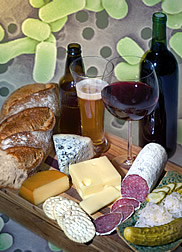This page has been archived and is being provided for reference purposes only. The page is no longer being updated, and therefore, links on the page may be invalid.
|
"Domesticated" Microbes Flex Industrial Muscle
By Rosalie Marion BlissNovember 16, 2006
A range of tangy and tart flavor compounds in hundreds of popular food and beverage products worldwide are the result of friendly fermentative microorganisms that carry out a variety of key biosynthetic processes.
Now, a consortium of public, private and academic researchers—including three with the Agricultural Research Service (ARS)—has decoded the DNA of nine representative strains of lactic acid-producing bacteria, or LAB.
While yeasts are responsible for putting the bubbles in beer and bread, LAB impart sharpness or mildness to cheeses and lively flavors to yogurt and kefir.
The study, published recently in the Proceedings of the National Academy of Sciences, was done by a multi-institute group of academic researchers under the Lactic Acid Bacteria Genome Consortium, headed by microbiologist David Mills at the University of California-Davis. Among the researchers were ARS microbiologists Fred Breidt and Ilenyz Diaz-Muniz, and plant pathologist Patrick Wechter. The multi-year study also involved scientists with the Walnut Creek, Calif.-based Department of EnergyJoint Genome Institute, which coordinates with the U.S. Department of Agriculture on targeted DNA sequencing projects.
The versatile LAB produce lactic acid as an end product of enzymatically fermenting lactose, or milk sugar, without the assistance of exposure to air. The metabolism of this functional clan of bacteria has been exploited for thousands of years to preserve nonrefrigerated foods.
One finding based on comparative genomic analysis uncovered coding regions that allow LAB to produce antimicrobials. Bacteriocin, for example, is produced by certain LAB strains and has been found to inhibit the human pathogenic bacterium Listeria monocytogenes.
The data allow researchers to better understand how the LAB’s fermentative gymnastics can be exploited for new biobased and other industrial applications. The polymer dextran, for example, can be biologically produced when one of the newly sequenced LAB—Leuconostoc mesenteroides—acts on cane or beet sugars. Dextran can be used as a biobased chemical ingredient in commercial products such as cosmetics and pharmaceuticals.
ARS is USDA's chief scientific research agency.

